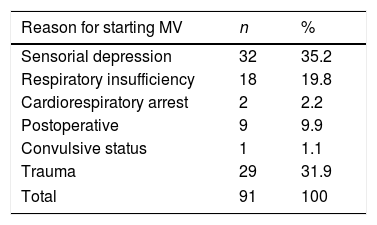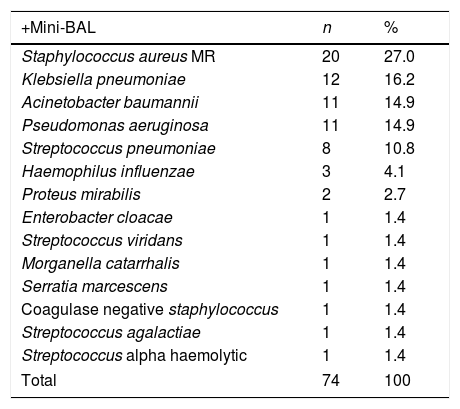Procalcitonin (PCT) can help the early diagnosis of bacterial infections and estimate the response obtained. The objective is to study the value of PCT for the diagnosis of ventilator-associated pneumonia (VAP).
Patients and methodProspective and observational study, carried out for 18 months, in a polyvalent Intensive Care Unit (ICU). Those included were over 18 years of age, with suspected pneumonia after 48h of mechanical ventilation (MV). Collected were demographic characteristics; admission pathology; reason for beginning MV; gravity scores (APACHE II, SAPS II and SOFA); C-reactive protein (CRP) and PCT. At the time of suspicion of VAP: early or late, radiological severity, presence of septic shock, SOFA, CRP, PCT and microbiology.
ResultsNinety-one patients with suspected VAP were included. The mean age was 42 (17.76) and that of hospitalisation in the ICU was 18.59 (11.69) days. VAP was confirmed in 74 patients, of which 19 (25.7%) presented septic shock. The mortality was 28.4%. There were no significant differences of the PCT in the patients who presented VAP versus those who did not present VAP (p=0.449). When patients without VAP, with VAP and VAP with shock, were compared, the PCT median was 0.38 (95% CI: 0.22–1.90), 0.56 (95% CI: 0.19–1.77) and 1.93 (95% CI: 0.38–10.07), respectively (p=0.169).
ConclusionsIn our study, PCT did not prove useful for the diagnosis of VAP.
La procalcitonina (PCT) puede ayudar al diagnóstico precoz de las infecciones bacterianas y estimar la respuesta obtenida. El objetivo es estudiar el valor de la PCT para el diagnóstico de la neumonía asociada a ventilación mecánica (NAV).
Pacientes y métodoEstudio prospectivo y observacional, realizado durante 18 meses, en una Unidad de Cuidados Intensivos (UCI) polivalente. Se incluyeron mayores de 18 años, con sospecha de neumonía luego de 48h de ventilación mecánica (VM). Se recogieron: datos demográficos, patología de ingreso, motivo de inicio de la VM, escalas de gravedad (APACHE II, SAPS II y SOFA), proteína C reactiva (PCR) y PCT. Al momento de la sospecha de NAV: precoz o tardía, severidad radiológica, presencia de shock séptico, SOFA, PCR, PCT y microbiología.
ResultadosSe incluyeron 91 pacientes con sospecha de NAV. La media de edad fue de 42 (17,76) años y la de internación en la UCI fue de 18,59 (11,69) días. La NAV fue confirmada en 74 pacientes, de los cuales 19 (25,7%) presentaron shock séptico. La mortalidad fue del 28,4%. No hubo diferencias significativas de la PCT en los pacientes que presentaron NAV y los que no la presentaron (p=0,449). Cuando se compararon los pacientes sin NAV, con NAV y NAV con shock, la mediana de PCT fue de 0,38 (IC95%: 0,22-1,90), 0,56 (IC95%: 0,19-1,77) y 1,93 (IC95%: 0,38-10,07), respectivamente (p=0,169).
ConclusionesEn nuestro trabajo la PCT no demostró utilidad para el diagnóstico de la NAV.











